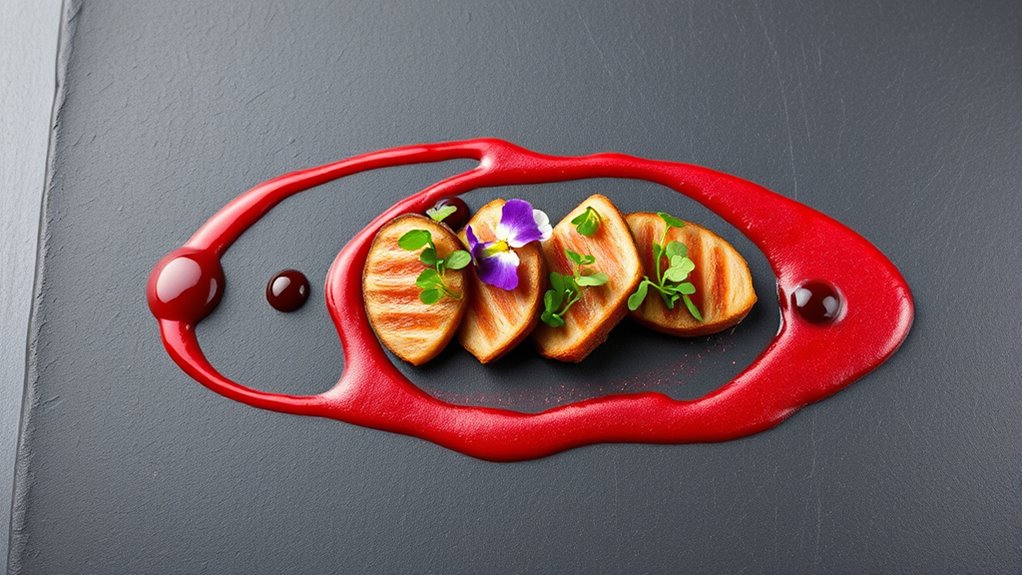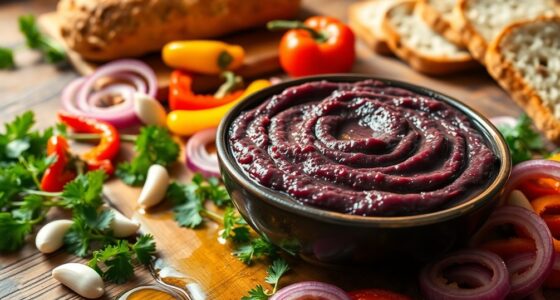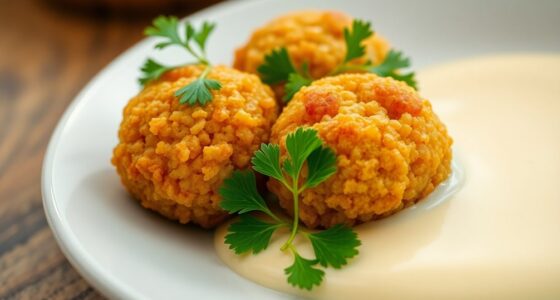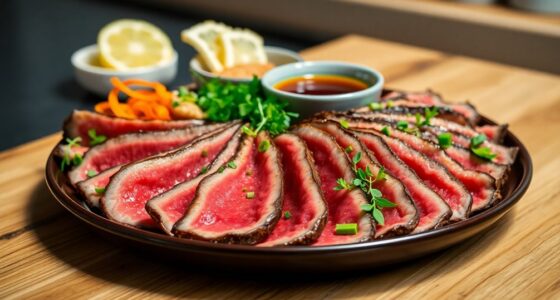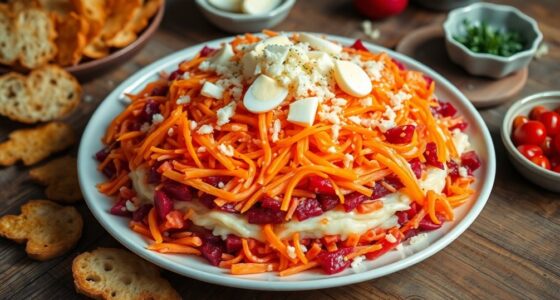The art of plating across world cuisines is all about creating visual harmony that reflects cultural traditions and culinary artistry. You’ll notice how Japanese dishes focus on balance and minimalist elegance, while Italian cuisine highlights rustic charm with vibrant colors. Middle Eastern displays are often elaborate and mosaic-like, and French presentations emphasize finesse and meticulous detail. When you explore different styles, you’ll discover how presentation not only enhances the dish but also tells a story—stick around to see how techniques and elements bring these traditions to life.
Key Takeaways
- Different cuisines emphasize unique presentation styles, such as Japanese minimalism, Italian rustic charm, Middle Eastern vibrancy, and French elegance.
- Effective plating highlights freshness, natural beauty, and the use of color contrast to enhance visual appeal.
- Cultural significance of presentation reflects respect for ingredients, craftsmanship, and culinary traditions across the world.
- Techniques like varied textures, precise garnishing, and thoughtful arrangement create engaging, artistic dishes.
- Presentation shapes perception, heightens anticipation, and creates a memorable culinary experience rooted in cultural storytelling.
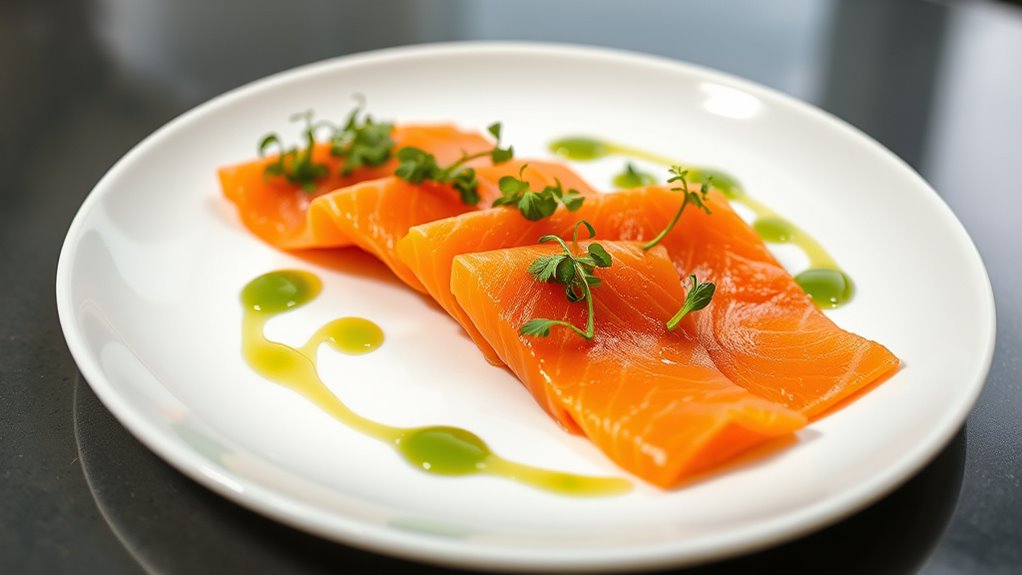
Presentation plays a crucial role in how dishes are appreciated across different world cuisines. When you sit down to enjoy a meal, your first impression often comes from how the food is arranged on the plate. The visual appeal can heighten anticipation and set the tone for the entire dining experience.
Presentation shapes how we perceive and enjoy dishes across cultures, setting the tone for a memorable dining experience.
In many cultures, beautiful plating isn’t just about aesthetics; it reflects respect for the ingredients, the chef’s skill, and the tradition behind the cuisine. Whether it’s the delicate art of Japanese sushi or the vibrant, layered look of a French terrine, presentation transforms simple ingredients into a work of art. It’s about creating a narrative on your plate that entices the senses and invites exploration.
In Japanese cuisine, presentation emphasizes balance and harmony. You might notice how sushi is carefully arranged to showcase the freshness of each piece, with bright colors contrasting against pristine white rice. The focus is on minimalism, allowing the natural beauty of the ingredients to shine through.
You’re encouraged to appreciate the subtlety and precision, which elevates the dining experience beyond just taste. Meanwhile, in Italian cuisine, presentation often revolves around rustic charm and vibrant colors. Think of a plate of Caprese salad with perfectly sliced tomatoes, fresh basil, and mozzarella, drizzled with olive oil. The emphasis is on simplicity and natural beauty, inviting you to enjoy the freshness and quality of the ingredients.
Moving to Middle Eastern cuisines, presentation can be quite elaborate, with dishes arranged in a way that highlights variety and abundance. You might see mezze platters with a multitude of small dishes, each carefully placed to create a colorful mosaic.
The goal is to stimulate your visual senses before you even taste the food, encouraging sharing and communal enjoyment. In French cuisine, presentation is often about finesse and elegance. Dishes are meticulously plated with attention to detail, from perfectly piped sauces to carefully placed garnishes.
This meticulousness reflects the cultural importance placed on artistry and precision, making each dish feel like a masterpiece. Additionally, the use of color contrast and varied textures enhances visual interest and makes dishes more enticing. Across all these cuisines, the art of plating isn’t just decorative; it’s an integral part of the culinary experience.
When you understand the cultural significance behind presentation styles, you gain a deeper appreciation for the food itself. It’s about engaging your eyes first, setting the stage for your palate to be delighted. Whether simple or elaborate, presentation connects you to the tradition, skill, and passion that chefs pour into their creations.
Ultimately, it transforms a meal into a memorable moment, where every element on the plate tells a story.
Frequently Asked Questions
How Does Plating Influence Perceived Taste?
When you see a beautifully plated dish, your mind expects a certain flavor experience. The presentation influences your perception of taste by creating anticipation and setting expectations.
If the plating is appealing, you’re more likely to enjoy the dish, perceiving it as more flavorful. Conversely, poor presentation can make food seem less appetizing.
Your eyes play a vital role in shaping your overall taste experience before the first bite.
What Cultural Symbols Are Commonly Included in Plating?
You see cultural symbols on plates when chefs incorporate patterns, colors, or items that reflect traditions, like cherry blossoms for Japan or chili peppers for Mexico.
These symbols honor history and identity, making your dining experience more meaningful.
How Do Dietary Restrictions Affect Presentation Styles?
When you consider dietary restrictions, they influence presentation styles by encouraging creativity and thoughtful arrangement.
You might use separate sections or containers to highlight specific ingredients, making the dish visually appealing while respecting dietary needs.
You also focus on vibrant colors and textures to make substitutions stand out.
What Tools Are Essential for Advanced Plating Techniques?
Did you know that 78% of diners say presentation influences their perception of flavor?
For advanced plating, you’ll need tools like tweezers for precision, squeeze bottles for controlled sauces, and ring molds for perfect shapes.
Fine-tipped brushes help add detailed touches, while a torch can caramelize or add texture.
These tools empower you to create visually stunning dishes that elevate the dining experience and showcase your culinary artistry.
How Has Modern Technology Changed Traditional Plating Methods?
Modern technology has revolutionized traditional plating methods by making precision easier and faster. You now use tools like digital printers for detailed designs and 3D printers to create intricate edible structures.
Automated systems help you achieve consistent presentation, while apps assist in planning and visualizing plating concepts. These advancements allow you to experiment more creatively and efficiently, raising the standard of presentation and elevating the dining experience for your guests.
Conclusion
Remember, the art of plating isn’t just about making food look pretty — it’s about telling a story on your plate. When you master presentation, you invite your guests to experience a feast for the eyes and the palate. So, don’t just serve; craft your culinary masterpiece with passion and precision. After all, a beautifully plated dish is a silent symphony, inviting everyone to savor not just the flavors, but the artistry behind each creation.
